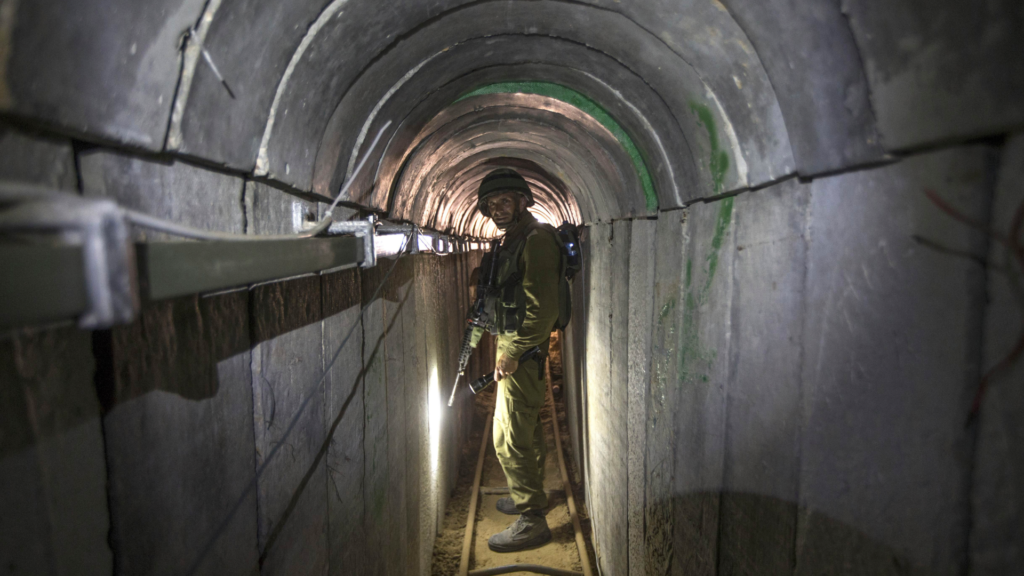Tunnels for Safety and Tunnels for Death
TRANSCEND MEMBERS, 27 Nov 2023
Kathy Kelly | The Progressive – TRANSCEND Media Service
An underground nuclear arsenal in Israel dwarfs the tunnels alleged at a Gaza hospital.
22 Nov 2023 – It’s one thing to burrow beneath the ground, digging to construct a tunnel for refuge, a passage of goods, or to store weapons during a time of war. It’s quite another for a small child to use one hand to dig their way out of the rubble that has collapsed on them.
Professor Mustafa Abu Sway, a professor based in Jerusalem, spoke sadly of the reality in Gaza where, he told Vatican News, “one child dies every ten minutes.”
“It was not the death of a child,” he said, “but the survival of one, that made me really very, very sad.” He was speaking of a video that had emerged showing a child buried alive under rubble attempting to free herself with one hand.
When we think of how to rescue suffering children from the unbridled carnage of numerous wars that have forced people to go underground, the vast network of tunnels built by the Vietnamese comes to mind. To this day, tourists in Vietnam can visit a network of tunnels created by the North Vietnamese, extending from the outskirts of Saigon to the borders of Cambodia. These tunnels, used both for shelter and by soldiers, were built during the war against the French occupation of Vietnam in the 1940s and 1950s. Eventually, the complex system gave the North Vietnamese a form of leverage in their effort to fight against the United States military.
Following the U.S. defeat in Vietnam, weapons makers in the United States focused on developing ordnance that could destroy underground tunnels and bases. Bombs like the Paveway (GBU-27) were used against the Iraqi military in Operation Desert Storm where they were deployed on February 13, 1991, to attack the Amiriyah shelter in Baghdad. At that time, families in the neighborhood had huddled overnight in the basement shelter for a relatively safe night’s sleep. The smart bombs penetrated the Achilles’ heel of the building, the spot where ventilation shafts had been installed.
The first bomb exploded and expelled seventeen bodies out of the building. The second bomb followed immediately after the first, and its explosion sealed the exits. The temperature inside the shelter rose to 500 degrees Celsius and the pipes overhead burst, resulting in boiling water that cascaded down on the innocents while they slept. Hundreds of people were burned alive.
In Afghanistan, on April 13, 2017, the United States used a Massive Ordnance Air Blast bomb nicknamed MOAB, the Mother of All Bombs, to destroy a network of tunnels in the Hindu Kush mountains. The United States had helped the Mujahideen construct these tunnels during their war against the Soviet Union in the late 1970s.
The 21,000 pound MOAB, designed to destroy tunnel complexes and hardened bunkers, still affects the area where it was used.
Locals say this harsh terrain has been haunted by a deadly, hidden hazard: chemical contamination.
Locals say this harsh terrain has been haunted by a deadly, hidden hazard: chemical contamination. According to one local resident, Qudrat Wali, “All the people living in Asad Khel village became ill after that bomb was dropped.” The twenty-seven-year old farmer showed a journalist red bumps that stretched across his calves and said, “I have it all over my body.” He said he got the skin disease from contamination left by the MOAB.
When Wali and his neighbors returned to their village, they found their land did not produce crops like it had before. “We would get 150 kilograms of wheat from my land before, but now we cannot get half of that,” he said. “We came back because our homes and livelihoods are here, but this land is not safe. The plants are sick and so are we.”
There are another kind of underground tunnels of a much more dangerous kind, and perhaps one of the most alarming underground concentrations for massive destruction. First built in 1958 and just about fifty-three miles from Gaza, there is a complex now called the Shimon Peres Negev Nuclear Research Center where at least eighty thermonuclear weapons have been developed. This facility underwent a major renovation just two years ago.
“To this day,” writes Joshua Frank, “Israel has never openly admitted possessing such weaponry and yet has consistently refused to allow inspectors from the International Atomic Energy Agency to visit the secretive site.”
A classic 1956 film depicting the horror of a Nazi concentration camp, Alain Resnais’s Night and Fog, contains narration that at one point addresses how these terrible sites will be seen in the future. “Nine million dead haunt this countryside . . . . We pretend that it could only happen once, in this place at that time . . . . The icy water fills the hollows of the mass graves, while war goes to sleep, but with one eye always open.”
Living as we do in a world where countries like the United States maintain a permanent warfare state, we must reckon with the horrific cost of war—and the obscene profits. The Merchants of Death War Crimes Tribunal notes that weapons makers’ stocks on Wall Street have risen 7 percent since the Israel-Hamas war started. Recognizing that war never sleeps, we must keep our eyes wide open and acknowledge the horrendous toll as well as our responsibility to build a world beyond war.
Living as we do in a world where countries like the United States maintain a permanent warfare state, we must reckon with the horrific cost of war—and the obscene profits.
As much as we might long to grasp the hand of the child trying to free herself from underneath a collapsed building’s rubble, we need to imagine and long for the chance to grasp the hand of someone outside our own community, someone we’ve been taught to regard as an enemy or an invisible “other.”
Writing these words from a safe, secure spot feels hollow, but in my memory I return to the pediatric ward of an Iraqi hospital when Iraq was under a siege imposed by U.S. and U.N. economic sanctions. Agonized and grieving, a young mother, her world crashing in on her, wept over the dying child she cradled. I came from the country that forbade medicine and food desperately needed by each of the dying children in this ward. “Believe me, I pray,” she whispered, “I pray that this will never happen to a mother who is from your country.”
_________________________________________
 Kathy Kelly is a member of the TRANSCEND Network for Peace Development Environment, an American peace activist, pacifist and author, one of the founding members of Voices in the Wilderness, and currently a co-coordinator Voices for Creative Nonviolence. Three times since 2000, she has been nominated for the Nobel Peace Prize. As part of peace teamwork in several countries, she has traveled to Iraq twenty-six times, notably remaining in combat zones during the early days of both US-Iraq wars. Her recent travel has focused on Afghanistan and Gaza, along with domestic protests against U.S. drone policy. She has been arrested more than sixty times at home and abroad, and written of her experiences among targets of U.S. military bombardment and inmates of U.S. prisons. She lives in Chicago. Kathy@vcnv.org – info@vcnv.org
Kathy Kelly is a member of the TRANSCEND Network for Peace Development Environment, an American peace activist, pacifist and author, one of the founding members of Voices in the Wilderness, and currently a co-coordinator Voices for Creative Nonviolence. Three times since 2000, she has been nominated for the Nobel Peace Prize. As part of peace teamwork in several countries, she has traveled to Iraq twenty-six times, notably remaining in combat zones during the early days of both US-Iraq wars. Her recent travel has focused on Afghanistan and Gaza, along with domestic protests against U.S. drone policy. She has been arrested more than sixty times at home and abroad, and written of her experiences among targets of U.S. military bombardment and inmates of U.S. prisons. She lives in Chicago. Kathy@vcnv.org – info@vcnv.org
Go to Original – progressive.org
Tags: Ethnic Cleansing, Gaza, Genocide, Hamas, Israel, Mass murder, Massacre, Palestine
DISCLAIMER: The statements, views and opinions expressed in pieces republished here are solely those of the authors and do not necessarily represent those of TMS. In accordance with title 17 U.S.C. section 107, this material is distributed without profit to those who have expressed a prior interest in receiving the included information for research and educational purposes. TMS has no affiliation whatsoever with the originator of this article nor is TMS endorsed or sponsored by the originator. “GO TO ORIGINAL” links are provided as a convenience to our readers and allow for verification of authenticity. However, as originating pages are often updated by their originating host sites, the versions posted may not match the versions our readers view when clicking the “GO TO ORIGINAL” links. This site contains copyrighted material the use of which has not always been specifically authorized by the copyright owner. We are making such material available in our efforts to advance understanding of environmental, political, human rights, economic, democracy, scientific, and social justice issues, etc. We believe this constitutes a ‘fair use’ of any such copyrighted material as provided for in section 107 of the US Copyright Law. In accordance with Title 17 U.S.C. Section 107, the material on this site is distributed without profit to those who have expressed a prior interest in receiving the included information for research and educational purposes. For more information go to: http://www.law.cornell.edu/uscode/17/107.shtml. If you wish to use copyrighted material from this site for purposes of your own that go beyond ‘fair use’, you must obtain permission from the copyright owner.
